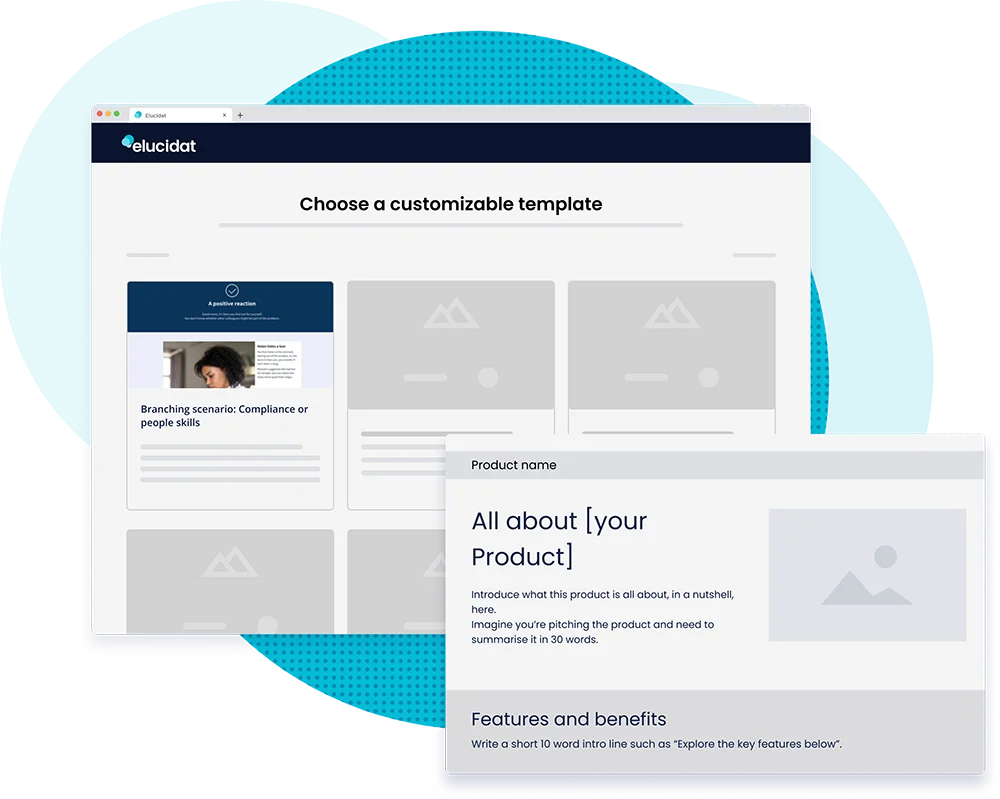What is a digital learning and development strategy?
Businesses have faced a lot of turbulence in recent years. Economic pressures. Rapid technological advances. Emerging skill gaps. Organizations have navigated these challenges with the support of L&D teams. And this is only going to continue.
As new technology transforms the way we work, the demand for online learning has never been higher. So, it’s no surprise that digital is important or very important to their overall L&D strategy for 96% of learning leaders.
But what does a successful digital learning strategy look like? Why do some of these organizations drive impact from their digital learning, while others fail to reap the Return On Investment (ROI)?
A digital learning strategy isn’t just about the success of an individual project. It’s a plan for how your business will create and use digital learning in all its forms. That means identifying smart ways to produce elearning at speed and scale. This guide sets out the steps you can take for successful online learning that delivers real business impact.
Many organizations start their digital learning initiative with expectations similar to, ‘We have 50,000 hours of learning for all our employees! Can you imagine the impact this initiative will have?!’ However, such a broad initiative often lacks focus and strategy. One year later, the utilization rate for noncompliance courses is often below 10%. After all, just because your local library has 10,000 books doesn’t mean you will read all of them—or even go to the library. Centre for Creative Leadership: ‘6 strategies for digital learning success’
Make your digital learning the go-to place for answers and learning in your organization, time and time again. Drive up user engagement, reach, reuse and, of course, the impact of your digital learning on business performance and productivity by reading on.
We’re struggling to increase engagement, and therefore retention, with our content.”
We have libraries of content with no clear context or goal and no link to employees’ careers.’’
Issues highlighted by survey respondents to the State of Digital Learning Report 2024
Our role is to signpost to key learnings but everyone’s getting lost in the enormity of everything.”
What is a digital learning and development strategy?

In a nutshell, a digital learning and development strategy is about shaping the way your organization uses digital learning in all its forms. This can range from blogs and videos to webinars and online collaboration through to online courses, immersive experiences and resources. The aim is always to help employees learn new skills, enhance their performance or develop themselves for the future.
“Digital Learning does not mean learning on your phone, it means ‘bringing learning to where employees are.’ It is a ‘way of learning’ not a ‘type of learning.”
A modern digital learning and development strategy…
How digital fits in your wider learning and development strategy
The majority of organizations make use of a range of learning and development methodologies. This incorporates synchronous (learning you complete at the same time as others) and asynchronous (learning you complete at your own pace) offers. Digital learning can take either of these forms.

Using a combination of learning formats is called a blended learning strategy. For example, one initiative might start with asynchronous learning made up of a video teaser and followed by elearning. This could be supported by synchronous learning during a team meeting on Zoom. You may also include in-person training, such as a one-to-one coaching session with a manager, where relevant.
Don’t dive straight and start creating content. Successful organisations think holistically about their overarching L&D blend first. Consider which methodologies drive the best results in different places during the learning journey. This enables you to focus on the role digital learning plays in your blend. So, whether you’re reviewing your employee training program or shifting your learning to the point of need, a blended learning strategy can help you maximize your impact.

“Too often in the past, we’ve created learning programs, and that’s the endpoint. But learning shouldn’t end. So around it, we built lots of different things to support people who are going through that training…and make sure the training was embedded.”
Jason Flynn, Global Head of Learning at GfK
Top tips for getting started with blended learning
Synchronous learning vs asynchronous learning – What are the benefits of each?
The best blended learning and development strategies tap into the highest value opportunities offered by the different modes of learning. So, which mode is best for what?
Having a clear list of the benefits of synchronous learning vs asynchronous will help guide your team and strategy. Here are some tips.

5 benefits of synchronous learning

Conversation
Participants can discuss, share stories, and ask questions.

Collaboration
Participants can work together in real time on tasks and activities and learn from one another.

Can practice
Participants can try things out and talk to other people within the organization.

Carry out roleplays
Test out conversation, presentation, facilitation and coaching skills, and get feedback from peers and experts.

Coaching
Facilitators and experts can guide and coach participants, support them, recap points or push them further as and when needed.
Virtual classrooms, video conferences and online group work lends itself to many of the above.
5 benefits of asynchronous learning

Empowering
opportunity for workplace learning and development is the #1 reason people want to work at an organization. Technology puts learning and development in the hands of your end users and offers them freedom around how and when they use it.

Measurable/Flexible
with learning analytics available within most modern learning tools, digital learning enables you to track employee engagement with learning. This includes shares, drop-off points, user comments and lots more.

Connected
xAPI learning technologies can connect the dots between all kinds of resources, experiences and activities that make up an individual’s learning journey. This enables you to guide employees from one relevant piece to the next to make learning continuous.

Always available
people learn on the fly, in the moment, on their commute – basically when they can or when they want to. Digital learning is always on and can be delivered in bite-size pieces that allow it to be used flexibly.

5 Personalized
modern learning technologies enable you to produce personalized or adaptive learning solutions that target an individual’s role, needs and skills gaps.
To explore more about the importance of elearning, take a look at the benefits of elearning in the workplace.
Fight the forgetting curve: weaving spaced learning into your blend
Even the best blend will have a limited impact, if it doesn’t stick. Creating long-term memories is crucial for effective learning. But research has proven that this isn’t easy. German psychologist Hermann Ebbinghaus’ pioneering trials on human memory illustrate that retaining information isn’t a given. According to the Ebbinghaus Forgetting Curve, people only retain 21% of what they learn within a month.
So how do you combat this?
Rather than asking learners to sit through hours of learning which they’ll likely forget in a month’s time, space it out. Break learning into short chunks. Introduce concepts and increase the complexity over time. Provide opportunities to reflect and practice. This spaced repetition allows you to build up learner competence and confidence incrementally across a period of time.

”Creating a memory, in psychology, is the process of encoding, storing and retrieving. That makes it sound pretty simple, right? I learned something. I encode it, I store it, I get it in there and then I just bring it back out when I want it. It makes it sound like it can happen a lot faster than it does. Whereas the neuroscience, when you look into the brain, it might have to grow a whole new piece of brain network to do this. The brain is expending a lot of energy and requires a lot of dedicated focus to learn and to create that memory.”
Lauren Waldman, Founder, Learning Pirate
Joining forces with the brain to deliver long term L&D impact
Top tips for creating effective spaced repetition

Focus on actions
Explore activities that build competence, confidence, and skills. Work back from these to consider what learners need. That could be guidance, examples, expert tips – to name just a few.

Personalize the learning curve
Send out learning on a regular basis or let employees work through the content more freely, unlocking the next level as they go. If your elearning platform has the functionality, adapt the content based on how the learner is doing.

Build in incentives
Consider allocating scores, badges, certificates or some kind of reward for completing parts of the learning. Help your learners celebrate with social media links.

Create a scale
Work out what learners should start with and where they can go from there. For example, you might want to create challenges that get incrementally harder.

Create milestones
Even if the learning is covering a big expanse of skills and competencies, don’t let it go on forever. Everyone needs a sense of completion and greater achievement.
To explore more ways to maximize your impact, check out our 5 tips to make your microlearning strategy really deliver.
How to create a successful digital corporate learning and development strategy
Today learners actively seek answers to their questions online and expect digital learning to be part of their workplace offering.
So, how do you shape a successful digital learning strategy in your organization? Can digital learning, in its many forms, meet the needs of the business and end users across your whole organization?

Is it possible to be people-centered and personal, yet produce online learning efficiently and at scale?
“Digital learning is an increasingly regular part of all employees’ lives. Last year, people were accessing learning every month and quarter. Now, it’s becoming a more daily and weekly commitment. Although there’s been a rise in employees completing digital learning at home, usually on a desktop or laptop, this generally happens during working hours. 85% complete digital learning during working hours.”
Explore these and many more stats on what modern enterprise learners want.
Traits of an effective digital learning strategy – L&D team dos and don’ts

- Identify performance needs by working with end users
- Speak to employees and experts to discover the most useful content and approaches for them
- Connect the dots between useful content that already exists
- Support people to work toward developmental goals by helping them navigate the most useful learning experiences and ensuring they have time to complete these within working hours
Overall, an empowering approach rather than top-down delivery helps your L&D strategy deliver more impact.

- Take a “top down” or content-led approach, ignoring your audience
- Take “orders” for training requests from senior leaders without challenge
- Push new content and courses out as a way to solve all problems – adding to employee overwhelm
- Think short term only, and in siloed, role-specific ways that disable talent from growing or moving roles
Common challenges L&D teams face
Successfully integrating digital learning into your corporate learning and development strategy is not easy. L&D teams in large organizations face huge variations in:
- Location and time zones of employees and their team
- User needs and expectations
- Business and customer requirements
- Language and culture
- Technology systems and habits
- Manager relationships and approaches
- Performance reviews and development planning
- What they are “told” is a learning priority by top leaders
This is why successful elearning strategies are never one size and shape and include multiple goals and measures of success.

5 reasons why your digital learning strategy should not start with technology


Effective learning starts with understanding key performance and employee challenges. Jumping into a specific tech option before shaping the problems could lead you down the wrong path.

Your employees are probably already using some tech platforms for learning – informally or formally. Think Teams, Slack, your Intranet. There could be a good reason not to break that habit.

Investments in learning technology do not directly affect learning impact – it’s what you do with it that counts. Adding in yet more technologies can actually hinder productivity and usage, not boost it.

Seize the opportunity to learn before you expand. Unearth the successes and failures of previous learning tech investments before you invest in others.

You might not need new technology. Many modern xAPI-based digital learning platforms are able to knit together content and learning experiences held in different formats, in different places, and track and present individualized user journeys. It may be that you don’t need to move everything to a new place, but instead focus on creating a seamless learning ecosystem.

“Artificial Intelligence (AI) isn’t replacing any of the roles that I’ve ever been in in L&D. I still have those technical knowledge requirements. I still need to review all of my content for accuracy. Instead of thinking about tech as in competition for your job, we just need to see it as an enhancement or an accelerator.”
Angie Elliott, Manager of Sales Enablement and Talent Development, Hormel Foods
If you are in the market for new learning technologies – be it social learning platforms, learning experience platforms, learning management systems, learning content management systems, authoring software, curation tools, AI tools and more – the first step is to put together your wish list of requirements by in-depth consultation.
You need to get to the heart of actual, typical or major performance challenges real employees face, why those challenges or barriers exist, and what would actually help them. You can do this by using learning analytics, user surveys and data around the use of previous tech alongside other training needs analysis methods.
Explore more about available learning technologies and how to put together your buyer’s wish list with the Ultimate authoring buyers guide.
5 tips to developing a winning digital learning strategy

Tip #1 Don’t start with learning technology
While technology is at the heart of digital and modern workplace learning, don’t reach for new tools and platforms straight away. Technology in itself is not the (full) answer.
 What not to do:
What not to do:
- Get software
- Spit out learning
- Add content
- Expect it to be used
Tip #2 Consult
82% of people are more likely to stay at a company if it invests in their professional development. However, 60% of employees in large organizations rate their elearning as fair to poor. L&D’s efforts are clearly falling flat.
Modern technology makes it super-easy to create, curate and share new courses and content. But should you?
“The idea is you stop people – stakeholders, clients, the business – at the point they say, ‘we need a course’. And let’s not be rude about our clients. We exist to serve the business. The reason they come to us and say, ‘we need a course’, and ultimately, we start to feel like order takers, is because all they’ve known is education. That’s what they think we do. They think they understand our role and what we do. And unless we demonstrate – show not say – something better or different, why wouldn’t they?”
Stop going through the motions and start delivering learning impact
Nick Shackleton-Jones, CEO and Founder of Shackleton Consulting

Get close to the real problems
Effective modern learning and development teams shift their focus from “what can we produce” to “what is actually needed?” They do this by consulting with different areas of the business, with managers and employees, to uncover performance barriers and gaps that need dealing with.

Prioritize on key goals
Find five or less focus areas that will actually unblock productivity or performance for the business. Over a year, this will have a far greater effect than trying to deliver a solution to every “training need” you are told about by managers.

Use learning analytics
An effective digital learning and development strategy will also focus heavily on using learning analytics and having defined a goal. You should ideally be checking in on the progress of your strategy against that goal to get the product right.
“Make sure you capture the data and evidence and understand it. Capture the data upfront. Quantify the problem. Test your thing, showcase the potential impacts, then go do it again. It sounds really simplistic, but [otherwise] you’re just playing around the edges, doing nice stuff, keeping your conspiracy going.”
Tackling flatlining business productivity with future focused L&D
Simon Gibson, Group Head of Learning & Development at Marks and Spencer
Carry out a learning technology audit
What is getting used for workplace performance support and development by employees? (Don’t assume but ask and observe!)
Is it what you expected? How can you bolster that? How can you streamline any disjointed parts of people’s exploration of “digital learning” in your organization? What opportunities can you see in the current picture that help bring learning into the workflow?
Pink link box:
Case study: How data-driven elearning created growth and widened reach
Tip 3: Cull and consolidate content
An effective modern L&D team who already has a lot of digital learning content out there will take the time to clear out the clutter. Old courses that are out of date and don’t work across devices will drag down the user experience, damage the reputation of your digital learning content and do more harm than good. Even if the content itself is valid.
If you have 23 available resources to help someone meet a specific performance goal:
- Pick out the best (use analytics to help you)
- Promote those above all
- Ensure all content is simply and clearly labelled
- Make sure learners can hop from one piece to the next easily, as they want
- Filter for different roles and levels of experience

“Now is a really good time to Marie Kondo your content. Pick out each piece of learning that does not spark joy. We built a lot of stuff during the pandemic. It’s time to go through it and to say, what’s working? What doesn’t work? What needs to be distilled?’
Lori Niles-Hofmann, Senior Learning EdTech Transformation Strategist at NilesNolen
Supporting the shift to becoming a skills-based organization
Tip 4: Curate and socialize learning
Content curation is always popular with L&D teams. Of course, it can save time and budget compared to creating content from scratch. But it can also create a more user-friendly learning experience.
Curate useful digital experiences, discussion points, and performance support resources that relate to a given topic or goal. Make sure learners can connect the dots to easily access them, through technology.
Grassroots or ground-up learning
An effective digital learning ecosystem sees employees sharing and liking resources from outside and inside the organization, both content that’s ground-up and content that’s formally been created. Actively enable and support ground-up approaches and the socialization or sharing of learning, in any form.
As part of your L&D strategy, you should find a way to support and utilize this social and grassroots movement. And that goes back to consulting – paying attention to what goes on, where – and building on that.
“Partnering with Elucidat experts was the best investment SGS could make. It allowed our team to discover the “digital learning designers” in them. The partnership allowed them to create and deliver with speed.”
Tip 5: Embrace Collaborative Content Creation
Around a fifth of L&D teams highlighted that effective collaboration helped them respond to business needs last year. Collaborative Content Creation is about unlocking expertise from any employee within your organization to create effective learning. Opening up authoring to novice authors expands capacity and increases efficiencies. It also helps cover those specialist subject areas unique to your organization.
Embracing collaborative models and methods is critical to delivering impact at speed and scale. Organizations that focus on collaborative authoring by adopting this workflow have seen exceptional benefits, including;
- Cutting learning costs
- Filling skills gaps
- Meeting learning demand
- Seeing faster turnarounds
- Delivering impactful learning

“We don’t have a centralized training function, and we want to empower SMEs to build their own content. With the recent introduction of templates in Elucidat, they find it very easy to design their own content…What Elucidat has done is empowered our SMEs so they can create really engaging online learning”
Jo Grantham, Training Lead, Oxfam

“One of the ideas was to essentially build a community of people from all parts of the business that we’re able to either create or co-create solutions with us, and effectively start to remove ourselves from being a blocker.”
Jonathan Holmes, Digital Learning and Strategy Manager, Domestic & General
Want to find out more? Get some insider tips on how to set up successful collaborative content creation models from L&D leaders at Aviva, nCino, Coca-Cola and D&G and read more about Oxfam’s digital learning journey.
Summary

The key to an effective digital corporate learning and development strategy is a blended approach based on user-centered research. Digging into your employees’ current habits, needs, trends and opportunities will help your team set up a strategy for success now and in the future.
Digital learning has many benefits for the modern workplace. It doesn’t require large groups of people to be in one physical space working at the same pace. Instead, it prioritizes flexibility, personalization and learning in the flow of work. As technology continues to transform our workplaces, it’s time to make sure digital is at the heart of your blended learning strategy.
As you implement your strategy, make the most of learning analytics to discover what’s working and what you can iterate. Keep your ears to the ground and your eyes on the impact and your digital learning strategy will take off!
Back up your strategy with the right tools for the job
From transitioning to Elucidat, to making big project releases go smoothly, we’ll make sure your elearning is a huge success – both for your team and your learners.
Book a free tailored demo today
To see how Elucidat can help you to produce digital learning that delivers a transformational impact, as well as developing an effective online learning strategy.

Useful resources
- State of Digital Learning Report 2024 – Elucidat
- ‘6 strategies for digital learning success’ – Centre for Creative Leadership
- How to build an outstanding elearning development process: The complete guide – Elucidat
- The Power of Collaborative Learning – Josh Bersin
- Learning At Large Podcast – Elucidat
- Customer stories – Elucidat
- Learning Methods Factsheet – CIPD
- The ultimate authoring tools buyers guide – Elucidat






